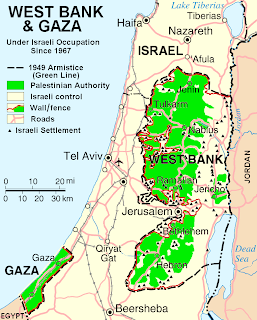The 1947 United Nations Partition Plan proposed a division of Mandate Palestine between an Arab and a Jewish state, with Jerusalem and the surrounding area to be a corpus separatum under a special international regime. The regions allotted to the proposed Arab state included what became the Gaza Strip, and almost all of what became the West Bank, as well as other areas.
The Partition Plan was passed by the UN General Assembly on November 1947. The Partition Plan was accepted by the Jewish leadership, but rejected by the Arab leaders. The Arab League threatened to take military measures to prevent the partition of Palestine and to ensure the national rights of the Palestinian Arab population. One day before the expiration of the British Mandate for Palestine, on 14 May 1948, Israel declared its independence within the borders of the Jewish State set out in the Partition Plan. US President Harry Truman recognized the State of Israel de facto the following day. The Arab countries declared war on the newly formed State of Israel heralding the start of the 1948 Arab-Israeli War.
After the war, which Palestinians call the Nakba, the 1949 Armistice Agreements established the separation lines between the combatants, leaving Israel in control of some of the areas designated for the Arab state under the Partition Plan, Transjordan in control of the West Bank and East Jerusalem, Egypt in control of the Gaza Strip and Syria in control of the Himmah Area.
In 1950, Jordan annexed the West Bank and East Jerusalem. Only the United Kingdom formally recognized the annexation of the West Bank, de facto in the case of East Jerusalem. In the Gaza Strip the Arab League formed the All-Palestine Government, which operated under Egypt occupation.
Article 24 of the Palestinian National Covenant of 1964, which established the Palestine Liberation Organization, stated: "This Organization does not exercise any territorial sovereignty over the West Bank in the Hashemite Kingdom of Jordan, on the Gaza Strip or in the Himmah Area" (i.e. the areas of the former Mandate Palestine controlled by Jordan, Egypt and Syria, respectively).
Israel captured both territories in the 1967 Six-Day War, as well as other territory belonging to Egypt and Syria. Since then, these territories have been designated Israeli-occupied territories. Immediately after the war, on June 19, 1967, the Israeli government offered to return the Golan Heights to Syria, the Sinai to Egypt and most of the West Bank to Jordan in exchange for peace. At the Khartoum Summit in September, the Arab parties responded to this overture by declaring "no peace with Israel, no recognition of Israel and no negotiations with Israel."
UN Security Council Resolution 242 introduced the "Land for Peace" formula for normalizing relations between Israel and its neighbors. This formula was used when Israel returned the Sinai Peninsula to Egypt in 1979 in exchange for a peace treaty. While that treaty mentioned a "linkage" between Israeli-Egyptian peace and Palestinian autonomy, the formerly Egyptian-occupied territory in Gaza was excluded from the agreement, and remained under Israeli control.
The Oslo Accords of the early 1990s between the Palestine Liberation Organization and Israel led to the creation of the Palestinian Authority. This was an interim organization created to administer a limited form of Palestinian self-governance in the territories for a period of five years during which final-status negotiations would take place. The Palestinian Authority carried civil responsibility in some rural areas, as well as security responsibility in the major cities of the West Bank and the Gaza Strip. Although the five-year interim period expired in 1999, the final status agreement has yet to be concluded despite attempts such as the 2000 Camp David Summit, the Taba summit, and the unofficial Geneva Accords.


